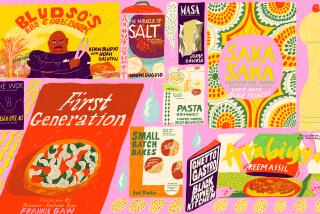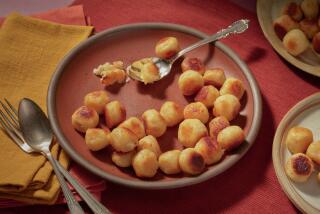The Dinner Pot : Take My Casserole . . . Please
In the history of cookery, there are few names more blighted than casserole. Mention it and heads politely turn away. Stomachs just turn.
That’s only fair. Perhaps more violence has been done to the human palate in the name of casseroles than any other single dish. But it’s important to remember one thing: Casseroles don’t kill palates--cooks do.
And while you may be deep in therapy trying to forget mom’s chicken a la king, would you be willing to give up the likes of choucroute garni, beef Burgundy and potato gratin? These days, a casserole is more a way of cooking than a specific dish. By today’s definition, a casserole is a one-dish meal baked in the oven and served in the pot in which it was cooked.
But it wasn’t always so. Originally, believe it or not, the dish called casserole was considered one of the grandest of a French chef’s creations.
“What would the culinary art be without the casserole, its principal ornament?” asked Alexandre Dumas in his 1870 “Grand Dictionnaire de cuisine.” “In France, the casserole is more honored than anywhere else. It is known that the Spaniards live only on chocolate, garbanzos and rancid bacon; the Italians on macaroni ; the English on roast-beef and pudding . . . . Consequently among us the casserole has made the reputations of many who have made use of the greatest talent.”
Of course, what he was talking about bears only a passing resemblance to today’s baked melange of convenience foods. In classical cooking, a casserole was a dish of rice molded in a form and filled with a stew of some kind before baking. John Nott’s “Cook’s Dictionary,” published in 1726, has two recipes for casseroles. The first is for a deep dish lined with rice and filled with a stew of mushrooms, veal sweetbreads, coxcombs, artichoke bottoms, truffles and morels. The second is for something closer to a savory pie: a hash made from leftover meat is served in a hollowed-out loaf of bread.
*
Though these sound as far from your basic tuna-noodle bake as the Palace of Versailles is from a three-bedroom ranch house, in an odd way all the modern elements are there: a stew of some kind--perhaps leftovers--with a starch crust. And, at least in the first dish, we see the kind of elaborate, freewheeling combining of ingredients that, when applied by lesser lights to canned mushroom soup, peas and tuna, ultimately caused the casserole’s fall into disrepute.
In fact, this definition of the casserole continued. For the first 30 years of this century, there is but one type of casserole in Fannie Farmer’s “The Boston Cooking-School Cookbook,” and it is made from stewed leftover meat steamed in a rice mold and turned out for serving.
But then, a second--strictly American--definition of casserole developed. With the proliferation of American pottery factories and the resulting low prices for--and increased popularity of--earthenware dishes, a casserole could also be defined by the earthenware, oven-proof dish in which it was cooked.
“The origin of the casserole is rather obscure, but good authority has it that the dish gets its name from France,” says Olive M. Hulse in her 1914 book “200 Recipes for Cooking in Casseroles.” “Until the last century, earthenware was brought mostly from Holland; later the potteries of England began sending great quantities of it to foreign countries, and now our own American manufacturers have turned their attention (to making the casserole).”
A contemporary of hers, Marion H. Neil (“Principal, Philadelphia Practical School of Cooking; Best Recipe Editor, Ladies’ Home Journal”), wrote in her 1912 book “How to Cook in Casserole Dishes”: “Properly speaking, a casserole is a dish. Of late years the prices of these utensils have been reduced so greatly that they are within the reach of the most modest housewife’s pocketbook, and then at the same time the actual pots and fireproof dishes have been improved enormously in quality.”
She promptly pads out her cookbook with recipes for everything from breads to salads (including one of “alligator pear,” which is nothing more than avocados and tomatoes chopped up). The single unifying element is that they are all served (if not, as in the case of the salads, cooked ) in an earthenware dish.
*
And, sounding an ominous note, Neil points out that “the keystone to the charm of casserole cooking is the economical features. It is a saver of time, fuel, labor and materials. Leftovers may be easily and quickly transformed into creamed or deviled dishes.”
While early casserole dishes were deep, lidded things, any kind of oven-proof earthenware container could now be considered a casserole--as well as anything that was cooked in it. Hulse pointed out: “The casserole enthusiast will avail herself of many different varieties as they have their individual usefulness; the deep oval casserole in which to cook a whole chicken . . . the shallow oval dishes for steaks . . . and the flat dishes for braising and shirring. There are also cunning little ramekins . . . which are just big enough to cook an egg. . . .”
And in the 1929 edition of “The Boston Cooking-School Cookbook,” we begin to see a division between two types of casserole recipes, with a clear distinction drawn between a casserole of something (such as the original meat and rice) and something cooked en casserole (generally braised sorts of things baked in casserole dishes). This continued until the 1951 edition, when everything became simply “casserole,” including the original meat and rice casserole, which--while retaining exactly the same ingredients--was now baked, rather than steamed.
The next great innovation in casseroling (yes, by now the word was also being bandied as a verb) began just before World War II, when the burgeoning food industry kicked into high gear. Even during the early, grand days, casseroles had been viewed as a wonderful final resting place, however gilded, for leftover meats and vegetables. What canned foods did was give the cook instant leftovers--canned meats and vegetables that were already cooked and ready for combining. The preparation of a simple white sauce and the sprinkling of some (packaged) bread or cracker crumbs on top were all that was needed for a one-pot supper.
The introduction of canned cream of mushroom soup by Campbell’s in 1934 provided the final push. Now, even the white sauce was pre-prepared. A cook could combine a can of soup, a can of vegetables, a can of meat, sprinkle a package of cracker crumbs across the top and bake. It didn’t take long for cooks (or cookbook writers) to catch on. By 1942, Marion Tracy’s “Casserole Cookery” was filled with canned and packaged ingredients.
“Being lazy and liking to cook and to entertain, we struggled futilely for a long time over how to combine these features pleasantly,” she wrote in her introduction, a kind of manifesto for can-opener casseroles. “Finally the thing came to us--that thing being a casserole. Stews and other wrongly demeaned dishes take on a dash of simplicity and sophistication when prepared in a casserole.”
*
By this point, even the nature of the cooking dish defined as a casserole had changed. While once made strictly of earthenware, by the time Irma Rombauer wrote the 1951 edition of “The Joy of Cooking,” she could proclaim: “Today the word casserole is applied to any deepish pot in which cooking actually goes on, or even to pots more rightly called sauteuses or deep skillets.”
Lousene Rousseau Brunner makes the point even more specifically in “Casserole Magic,” written in 1953. “(Manufacturers are producing) ever more fascinating casseroles, made of fireproof glass, glazed and unglazed earthenware, pottery, enamel baked on cast iron, and copper.”
Everyone, it seems, was jumping on the casserole bandwagon, including Jim Beard (in an effort at manly jocularity, not James), who collected a series of Argosy magazine articles and published it as “The Casserole Cookbook” in 1955. Despite sounding a bit strained at times (beefsteak in casserole is labeled a “real man’s dish!”), most of the ingredients are fresh, and the dishes actually sound quite good.
All of which proves, once again, that the casserole, in and of itself, is not necessarily a bad thing.
More to Read
Eat your way across L.A.
Get our weekly Tasting Notes newsletter for reviews, news and more.
You may occasionally receive promotional content from the Los Angeles Times.











